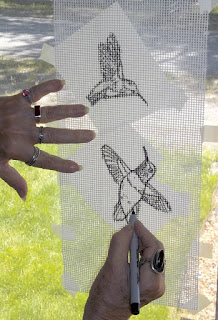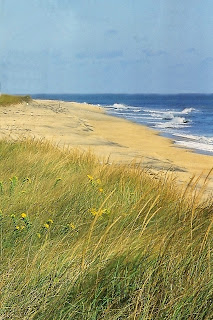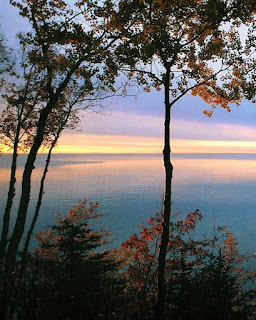 |
| Lake shoreline or ocean coastline? |
Before we begin our new topic, I would like to address two questions that I am frequently asked. The first is "Can I take what I'm learning about seascapes and use it for lakes?"
In most cases, the answer is a resounding "Yes!" This is particularly true if you have access to a large lake. I can assure you that Lake Michigan during a storm is as awesome as the ocean! You will not get the same wave forms and breakers that you would see on a seacoast, nor the large tidal differences. Sunrises, sunsets, fog and storms over lakes can be quite dramatic, however. and can be treated in the same way as those at sea. A solitary fisherman can provide as dramatic a silhouette as strollers on a beach. Boats of all kinds, docked or in motion, are always interesting. Lakes are also a good place for wildlife sightings, particularly of migratory birds. We had moose reintroduced to our area a few years ago and I'm hoping for a good sighting soon. By all means apply the principles you learn to lakes as well as the ocean. This photograph could be either a lake scene or an ocean one.
In most cases, the answer is a resounding "Yes!" This is particularly true if you have access to a large lake. I can assure you that Lake Michigan during a storm is as awesome as the ocean! You will not get the same wave forms and breakers that you would see on a seacoast, nor the large tidal differences. Sunrises, sunsets, fog and storms over lakes can be quite dramatic, however. and can be treated in the same way as those at sea. A solitary fisherman can provide as dramatic a silhouette as strollers on a beach. Boats of all kinds, docked or in motion, are always interesting. Lakes are also a good place for wildlife sightings, particularly of migratory birds. We had moose reintroduced to our area a few years ago and I'm hoping for a good sighting soon. By all means apply the principles you learn to lakes as well as the ocean. This photograph could be either a lake scene or an ocean one.
The second question, phrased in many ways, refers to the amount of planning I recommend before actually starting an art needlework project. Unlike painters, fiber artists (needlepointers, rug makers, quilters, weavers, embroiderers) cannot "paint over" areas of our work. Removing stitches is tedious and time-consuming and always runs the risk of damage to the underlying canvas or fabric. It is wise to work out as many details as possible before putting in that first stitch. (My favorite paint medium is watercolor, which is not as easy to modify or correct as some others, so I learned early to plan before I began.) This is just a practical reason for pre-planning.
But there are many more advantages to planning. Planning forces you to think about what you want to do. You must really look at the scene, animal, flower, or other subject you want to depict in needlework. Then you have many individual decisions that you need to make. What is the function of the piece — rug, picture, decorated clothing, table linens, etc.? How large will it be when it is finished? Will it need matting, framing, backing, edging? What is the style — realistic, stylized, cartoonish, geometric, abstract? Will you need to transfer the design to your canvas or fabric? Are you following a chart, or just working "free hand"? What is the color scheme? What materials will you need and how much of each one? What tools will you need? Do you have what you need on hand or must you buy some things? Make a shopping list. Once you have resolved all these questions, you will be able to begin your work with confidence and enthusiasm because you know your planning has been thorough.
Now back to seascapes! Seascapes can be planned in three main ways. The first of these is to look outward from the land to the sea. This is what we concentrated on in the first part of this series. The second is to look at the shore from the sea. We used one of J.J.'s photographs as a basis for demonstrating "gesture" in art. Let's remove the directional lines and look at the picture underneath.
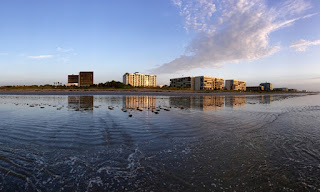 |
| Florida shoreline, photo by J.J. |
The city almost appears to float on the calm waters! Look at the clarity of the reflections of the buildings. Here is the scene as part of a larger panorama.
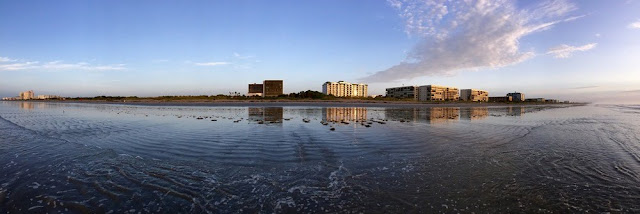 |
| Panorama of shoreline, as originally shot |
Whenever your scene includes a large portion of land, not just rocks that the sea is breaking over, you have a number of decisions to make. I am going to give you two simple sketches of a cove to illustrate this point. The sketches are identical except for one thing — the position of the sketch on the background. Please feel free to copy both sketches and develop them as you choose. I've made them very simple so that you can do that.
 |
| Simple sketch, cove at bottom |
In this sketch the cove is dominated by the sky, which occupies the top half of the background. Is the sky sunny or cloudy? Are the clouds fair-weather clouds or storm clouds? Is it sunrise, midday, or sunset? Is there anything besides clouds in the sky — a flock of migrating birds, perhaps, or colorful hot-air balloons? Is the cove just barren rocks? Is there a lighthouse on the point? Are there buildings? Are there boats anchored in the cove? Is the sky reflected in the water? You will need a balance between light and dark features. If the sky is light, how are you going to balance it by making the cove darker — or the other way around? What are you going to do with the small strip of foreground that is at the bottom of the sketch, closest to the viewer? Make your choices and indicate them with colored pencil, crayon, marker or pastel. Features will be small, so you need not put in a great deal of detail unless you want to do so.
Never underestimate the value of so-called "neutral' colors like beiges, tans, and the whole array of grays. Wet things — earth, sand, rocks, ropes, fishing nets — dry and lighten in color as they do so. Mixing strands of neutral floss or yarn into the "wet" colors or gradually lightening areas with closely related neutrals make such transitions look more natural and believable. An exposed rock, for example, may be considerably paler at the top, where it has dried, than it is at the bottom, where it is still wet.
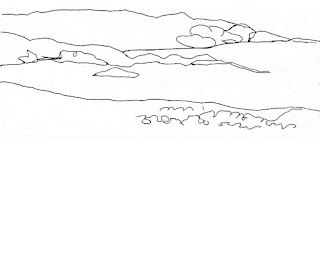 |
| Simple sketch, cove at top |
This time the sky is much less visible and plays very little part in the composition. The cove itself takes "center stage". But now that little strip of foreground that you could almost ignore in the first sketch takes up nearly half of the visual space in this one. Is the cove now the site of a village or a simple ridge of rock that the sea, surging in from the right, will break over? Is there a solitary fisherman standing hip-deep in the water/ A fishing net caught on the rocks? Is the foreground a part of the same rock formation, also battered by the sea? Is it a high elevation looking down on the scene below? Is beach grass growing on it? Are gulls coming in for a landing? Is it a stretch of sheltered beach where someone has built a sand castle? How are you going to balance the lights and darks this time?
 |
| Monochrome picture of breaking surf |
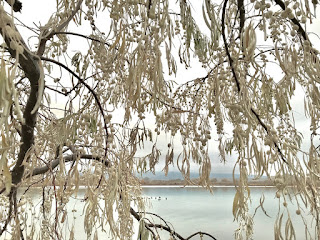 |
| A complex lakeshore photo by J.J |
For those of you working on lake scenes instead of seashores, you can easily modify the cove sketches. You may want to visualize trees along the point above the cove — hardwood trees in autumn foliage, perhaps, or darker evergreens. What else might you include? Canoes instead of fishing boats? A bear teaching her cubs to fish? The tents of campers? Snow falling softly? Ducks, geese, swans or other migratory birds in the water?
Grass blades, plant foliage, tree leaves, even evergreen needles eventually surrender their colors as the seasons of their lives come to an end. Showing their natural colors replaced with darker or more muted tones gives them a liveliness and reality in a composition that they would not otherwise possess. Take beach grasses for example. Even when the grasses die at the end of summer, their complex root systems serve to hold both the dead plants and the sand itself in place against the influences of wind, rain, and snow. If you are adding grassy dunes to your seaside composition, ask yourself if the green in the grass comes from new plants taking hold among the old ones or from hold-outs losing ground to the coming winter. The answer can set the tone for the whole composition — and determine the color scheme as well. Which brings us to the third way of composing a seascape — looking along the beach or seaside itself, while sea and sky act as "accessories" to complete the picture. This scene of beach grass and sand is a good example of what I mean.
Earlier I mentioned balancing dark and light in a composition. This doesn't mean that you should divide your design down or across its middle and make one half dark and the other half light. It does mean that if, for example, you have a light sky above dark water, you should have at least a small amount of dark tones in the light area (perhaps patches of deep blue sky between white clouds), and lighter tints in the dark area (perhaps white foam on the water or light-colored sand on the beach). It also means that if you have a large dark or light area or object at the center of your composition, you should have a smaller area of similar lightness or darkness close to one edge of the composition. Think about a see-saw. How does a large adult balance a small child on a see-saw? By moving closer to the center, while the child remains at the other end of the board. Try to make a composition that has some alternating light and dark areas. You may find that this is the most satisfying solution to the light/dark balance problem.
| "Cascades," a mixed needle arts picture demonstrating many of the points above |
I have given you a lot of ideas to consider. I'm sure you can think of many more. Experiment. Play with your choices. When you have considered the alternatives and when you have a combination that pleases you, begin the planning process. Then get busy and make that composition!
 This post by Annake's Garden is licensed under a Creative Commons Attribution-NonCommercial-ShareAlike 3.0 Unported License.
This post by Annake's Garden is licensed under a Creative Commons Attribution-NonCommercial-ShareAlike 3.0 Unported License.
